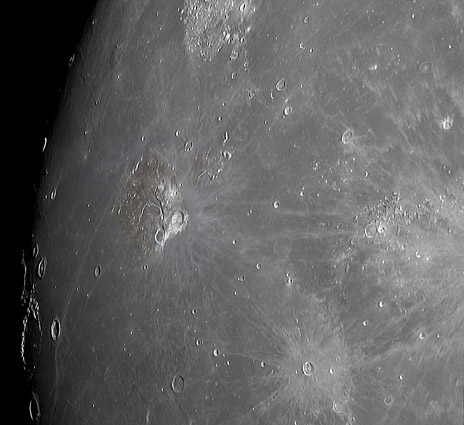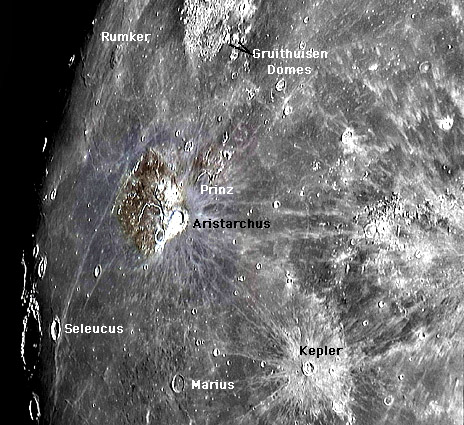Difference between revisions of "April 12, 2004"
(Created page with "__NOTOC__ =Procellarum Volcanic Group= ---- ===COMMENTS?=== Click on this icon image:PostIcon.jpg at the upper right to post a comment.") |
|||
| (10 intermediate revisions by the same user not shown) | |||
| Line 1: | Line 1: | ||
__NOTOC__ | __NOTOC__ | ||
=Procellarum Volcanic Group= | =Procellarum Volcanic Group= | ||
| − | + | <!-- Start of content --> | |
| − | + | <table width="640" border="0" align="center" cellpadding="6" cellspacing="2"> | |
| − | + | <tr> | |
| − | ---- | + | </tr> |
| − | === | + | </table> |
| − | + | <table width="85%" border="0" align="center" cellpadding="6" cellspacing="2"> | |
| + | <tr> | ||
| + | <td colspan="2"><div align="center"> | ||
| + | {{HoverImage|LPOD-2004-04-12.jpeg|LPOD-2004-04-12b.jpeg}}</div> | ||
| + | </td> | ||
| + | </tr> | ||
| + | </table> | ||
| + | <table width="100%" border="0" cellpadding="8"> | ||
| + | <tr> | ||
| + | <td><div align="center"><p>Image Credit: [mailto:j.schedler@panther-observatory.com Johannes Schedler]</p></div></td> | ||
| + | </tr> | ||
| + | </table> | ||
| + | <table class="story" border="0" bgcolor="#FFFFFF" width="90%" cellpadding="10" align="center"><tr><td> | ||
| + | <p class="story" align="center"><b>Procellarum Volcanic Group </b></p> | ||
| + | <p class="story" align="left"> Volcanic structures on the Moon tend to be small and inconspicuous. Oddly, the three largest and most unique lunar volcanic landforms all occur along a meridianal belt | ||
| + | in the northern half of Procellarum. From north to south they are Rumker, the Aristarchus Plateau and the Marius Hills. Nearby (mouse over to see where) is another smaller | ||
| + | but also unusual volcanic feature - the steep-side [[March_30,_2004|Gruithuisen Domes.]] [[February_15,_2004|Rumker]] is a 60 km wide | ||
| + | collection of coalescing domes. The [[January_17,_2004|Aristarchus Plateau]] has three peculiar features - it is a sharply bounded rectangular area | ||
| + | (often considered an uplift) incised by Schroeter's Valley, the largest sinuous rille on the Moon, both with a dusting of pyroclastic material from the Cobra Head | ||
| + | enlargement of the start of the rille. The Marius Hills is a collection of ~300 steep-sided domes and hills. The alignment of these three mega-volcanic features hints | ||
| + | that they are inter-related but there is no understanding of how. | ||
| + | </p> | ||
| + | <blockquote> | ||
| + | <p align="right" class="story">— [mailto:tychocrater@yahoo.com Chuck Wood]</p> | ||
| + | </blockquote> <p><b>Technical Details:</b><br> | ||
| + | Mar 16, 2003 21:00 UT webcam mosaic with the 4" TMB refractor at f/25; 200 images processed in Registax for each part; | ||
| + | final levels and curves adjustment in Photoshop. CAW strongly enhanced the mouse-over image using an unsharp mask filter | ||
| + | which brings out a purple colored halo that extends 200+ km beyond the Aristarchus | ||
| + | Plateau - this is presumably pyroclastic mantling from the Cobra Head eruptions. | ||
| + | </p> | ||
| + | <p class="story"><b>Related Links:</b><br> | ||
| + | [http://panther-observatory.com/ Panther Observatory]</p> | ||
| + | <p><b>Yesterday's LPOD:</b> [[April 11, 2004|Valley of the Alpes]] </p> | ||
| + | <p><b>Tomorrow's LPOD:</b> [[April 13, 2004|Apollo 13 on April 13]] </p> | ||
| + | </td> | ||
| + | </tr> | ||
| + | </table> | ||
| + | <!-- start bottom --> | ||
| + | <hr> | ||
| + | <p align="center" class="main_titles"><b>Author & Editor:</b><br> | ||
| + | [mailto:tychocrater@yahoo.com Charles A. Wood]</p> | ||
| + | <!-- Cleanup of credits --> | ||
| + | <!-- Cleanup of credits --> | ||
| + | <!-- Cleanup of credits --> | ||
| + | <!-- Cleanup of credits --> | ||
| + | <!-- Cleanup of credits --> | ||
| + | <!-- Cleanup of credits --> | ||
| + | <!-- Cleanup of credits --> | ||
| + | <p> </p> | ||
| + | <!-- End of content --> | ||
| + | {{wiki/ArticleFooter}} | ||
Latest revision as of 19:15, 7 February 2015
Procellarum Volcanic Group
Image Credit: Johannes Schedler |
|
Procellarum Volcanic Group Volcanic structures on the Moon tend to be small and inconspicuous. Oddly, the three largest and most unique lunar volcanic landforms all occur along a meridianal belt in the northern half of Procellarum. From north to south they are Rumker, the Aristarchus Plateau and the Marius Hills. Nearby (mouse over to see where) is another smaller but also unusual volcanic feature - the steep-side Gruithuisen Domes. Rumker is a 60 km wide collection of coalescing domes. The Aristarchus Plateau has three peculiar features - it is a sharply bounded rectangular area (often considered an uplift) incised by Schroeter's Valley, the largest sinuous rille on the Moon, both with a dusting of pyroclastic material from the Cobra Head enlargement of the start of the rille. The Marius Hills is a collection of ~300 steep-sided domes and hills. The alignment of these three mega-volcanic features hints that they are inter-related but there is no understanding of how. Technical Details: Mar 16, 2003 21:00 UT webcam mosaic with the 4" TMB refractor at f/25; 200 images processed in Registax for each part; final levels and curves adjustment in Photoshop. CAW strongly enhanced the mouse-over image using an unsharp mask filter which brings out a purple colored halo that extends 200+ km beyond the Aristarchus Plateau - this is presumably pyroclastic mantling from the Cobra Head eruptions. Related Links: Yesterday's LPOD: Valley of the Alpes Tomorrow's LPOD: Apollo 13 on April 13 |
Author & Editor:
Charles A. Wood
COMMENTS?
Register, Log in, and join in the comments.





